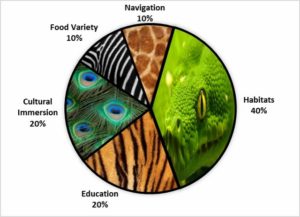
This page contains a breakdown of our ratings system. Steve and I use this system to rate the zoos we visit.
Our goal is to rate each zoo in a manner that is fair and consistent. We want to be fair regardless of a zoo’s location, size, budget, and climate.
Below is a descriptive and informative rundown on the different categories and their ratings. In some parts of this page, it gets pretty technical.
So if you are not into math and statistics, you may not find parts of this page interesting. We totally understand.
However, we wanted to be transparent in our overall and category ratings for each zoo. We hope you find our rating system to be fair and consistent for each zoo. We hope you find the information on this page helpful. Enjoy!
Since this is a ZOO review, we wanted our rating system to evaluate more than just the animal habitats.
Zoo should always provide a natural and enriching environment for the animals. Our feeling is zoos should also provide an enriching and educational experience to the visitor.
We LIKE visiting zoos where you get to see each species in its natural habitat. We LOVE visiting zoos where you can experience other educational, sensory, and cultural cues. This helps you see the big picture of each species’ place in the world.
Our overall ratings system based on five categories: animal habitats, education, cultural immersion, ease of navigation, and food availability.
Of these five categories, we rank animal habitats as the most important category. It accounts for 40% of the overall rating.
Education and cultural immersion each account for 20% of the overall rating.
In our experience, we also found ease of navigation and food availability to be important factors in the overall experience of the visitor.
Therefore, ease of navigation and food availability account for 10% each of the overall rating.
We considered several other categories for our overall rating. Ultimately, these are the categories we felt are the most important. They can be accurately evaluated in a single visit and are fair to zoos of all shapes and sizes.
We know a picture is worth a thousand words. So, we’ve included a picture of our rating system in the form of a pie chart.

Now let’s talk a little about how we rate each zoo for these categories.
Animal Habitats
When determining a zoo’s average animal habitat rating, we start by rating the habitat of each individual species. This is based on pictures, memories, and notes from our visit(s).
The habitat for each species is given a score between one paw and five paws.
- A score of one paw is given for habitats that are inadequate for the animal’s needs. We rarely assign a habitat a rating of one paw.
- A rating of two paws is given for habitats that are adequate for an animals needs but cater more to the visitor’s experience than the animal’s needs.
- A score of three paws is given to habitats that are adequate for the animal and provide a good balance between the animal’s needs and the visitor’s experience.
- A rating of four paws is given to habitats that provide an excellent, enriching environment for the animal.
- A score of five paws is given to habitats that are enriching for the animal and provide an excellent experience for the visitors.
We have developed a weighted average system for determining a zoo’s overall animal habitat rating.
Once the habitat rating for each individual animal species has been determined, those values are used in our system to determine an overall habitat rating for the zoo.
This may sound overly complicated, but again our goal is to be fair to all zoo’s regardless of their location, budget, size, and climate.
We want to reward overall quality of a zoo’s habitats and not quantity of species.
Education
As we said earlier, this is a ZOO review. This is not a wildlife park or sanctuary review.
Education should set a zoo apart from other organizations that house animals. Accordingly, we look closely at the educational materials of each zoo we visit.
- We assign a score of one paw to a zoo if they only have the species’ name of the animal(s) on exhibit.
- A score of two paws indicates the majority of the zoo’s enclosure signs contain some information about the animal in addition to the species’ name.
- A rating of three paws indicates the majority of the zoo’s enclosure signs contain substantial information about the species (range, diet, conservation status, etc.).
- A score of four paws indicates the zoo has shown a commitment to education. In addition to enclosure signs, the zoo provides some additional education exhibits and signage throughout the zoo.
- A rating of five paws is earned by zoos with a fully developed educational program. In addition to the educational signage found in four paw zoos, five paw educational programs include interactive exhibits. These exhibits are fun and engaging for all age groups. They can also be found in the majority of the zoo.
Cultural Immerison
Reading information about where a species is from and the cultures that interact with a species is good. Experiencing a piece of those locations and cultures has a much more profound impact on the zoo visitor.
When a zoo tries to provide the visitor a sample of the sights, sounds, and in some cases an opportunity to touch pieces of the cultures associated with a species. The visitor is more likely to remember and understand the educational information the zoo provides.
Cultural immersion can be the difference between a really good zoo and a great zoo.
- A rating of one paw is assigned to zoos that appear to make little to no effort to engage in cultural immersion.
- A score of two paws indicates the zoo provides occasional cultural cues sporadically throughout the zoo.
- A rating of three paws indicates the zoo consistently provides small cultural cues throughout the zoo.
- A score of four paws indicates the zoo provides immersive environments in several parts of the zoo.
- A rating of five paws is earned by zoos that consistently provide a culturally immersive environment. This is from the architecture to the finer details throughout the zoo.
Navigation
Zoo visitors should be able to find their way around the entire facility with, at most, occasional use of a map. The visitor should be able to focus their attention on the animals and educational exhibits.
They shouldn’t have to worry if they missed something when they went left instead of right at the last fork in the path.
- A rating of one paw is assigned to zoos that require a personal guide to navigate the facility.
- A score of two paws indicates navigation of the zoo requires a map. The visitor must also backtrack multiple times to see all exhibits.
- A rating of three paws indicates navigation of the zoo requires a map and occasional backtracking to see all exhibits.
- A score of four paws indicates a zoo map is not required and little to no backtracking is required.
- A rating of five paws indicates the zoo is easy to navigate without a map. The visitor will not miss any exhibits.
Food Variety
In an effort to be fair to all zoos, we have chosen to only rate the variety and availability of food. Some of the zoos we visit are far away from our home. We may only be able to visit them once or twice.
Steve and I have worked in the service industry. We understand there are the occasional bad days in any service based business.
We have chosen to not rate the quality of food or service at the zoo. This is in case we happened to visit on a bad day.
Also, if we had a bad food experience at a zoo we could only visit once, we would never know if the problem was fixed.
With that in mind we have chosen to only rate the food variety and availability. This is something that should be consistent for a one-time or regular visitor.
- A rating of one paw is assigned to zoos that only provide pre-packaged or bottled food options.
- A score of two paws is assigned to zoos that have restaurants where only a few of the standard concession stand items (hot dogs, hamburgers, nachos, popcorn, etc.) are sold.
- A rating of three paws indicates a zoo has a full selection of concession stand and grill items.
- A score of four paws is assigned to zoos with restaurants offering at least a few options beyond the standard concession stand items.
- A five paw rating is earned by zoos with multiple restaurants offering a wide variety of food selections.